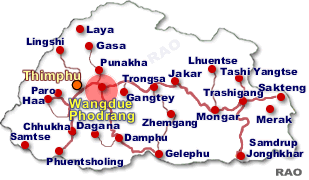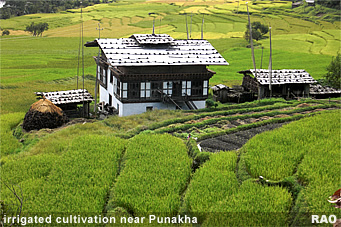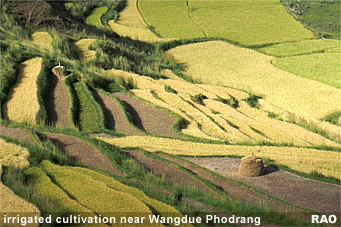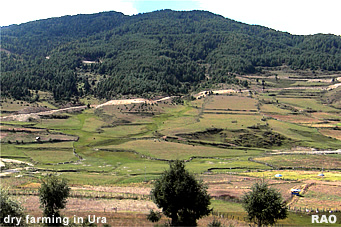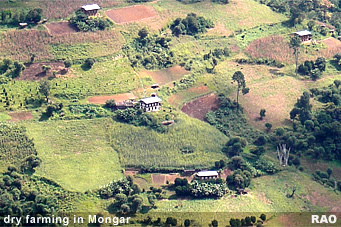 |
Bhutan's
Development: Telecom |
|
 |
Bhutan's
Development |
|
|
 |
|
Development in Wangduephodrang
|
|
Paddy fields lie fallow for lack of irrigation water
|
Except for the afternoon breeze rustling the leaves of tall bamboo plants and the birds chirping, Gaybakha is a quiet village these days. The terraced fields, which disappear into the forest, have become a grazing ground for cattle, with weeds and plants covering paddy stumps left after the 2008 harvest.
Gaybakha farmers had left their fields fallow this spring. The 12 households couldn't cultivate their staple crop, as there was no water in the irrigation channels.
Located on top of a steep hill, after climbing from Pinsa, a diversion from the Thimphu-Wangdue highway, the village looks almost deserted. Only old people and housewives have stayed back, as most people have left the village to do manual work at the roadside. "The money my son earns from doing logging work keeps my family of 15 going," said Norbu Dem, 60. She is among the few people, who stayed back to keep the home fires burning.
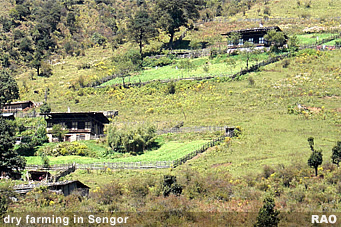 |
| According to Norbu Dem, who owns about six acres of cultivable paddy field and belongs to the richest household in the village, shortage of water has hit the village since 2000. At first, the fields located at the end of the village could not be cultivated, according to her. Then, in 2006, almost half the paddy fields had to be left fallow. "But this year was the worst," the mother of six said. |
|
Opening the door to her ground floor, she showedhow the harvest was affected. "Nine years ago, all these containers used to be filled with paddy rice," she said, pointing to four huge empty wooden boxes. "We use to store 1,200 drey (one drey is about 1.5 kg) of rice in each of these boxes," she said. "Today I store rice in tins and there is little in them."
top
|
Dry as a bone: Villagers hope the 10th Plan will quench their parched fields
|

|
| Ura
Valley, Mongar, dry farming |
Eating imported rice in the village was looked down upon by neighbours not so long ago, according to another farmer, Pema. "We used to cultivate enough to sell. Today, we're eating cheap imported rice," said the father of six. Farmers said it is a sore sight to see cattle grazing in the fields, which used to be filled with paddy heaps.
But help is not coming soon, going by what villagers say. The need for irrigation water was raised at any forum, even to individual government officials visiting the gewog. The village tshogpa (village representative) was asked to raise the issue at every gewog yargye tshogchung (GYT). |
 |
According to the village tshogpa, construction of the irrigation channel is a priority in the 10th plan. "But nothing's being done as of now," he said. "I went to the dzongkhag thrice to call the engineer for survey on the order of the gup, but the engineer couldn't come as he was always busy," said the tshogpa.
Daga gup Wangchuk said that, although Nu 200,000 was allocated for renovation of irrigation channel, the budget could not be used for Gaybakha since the water source was too small. "We've proposed a new irrigation channel."
Gup Wangchuk said that the gewog asked for the dzongkhag agriculture section's support, but the villagers did not receive anything, since the report was send to disaster management.
The dzongkhag agriculture officer, H P Adhikari, said that it is the late monsoon that hampered the paddy cultivation. "We've been improving our existing irrigation channels, but there's a shortage of water in the dzongkhag, especially when there's no timely monsoon," he said.
Back in Gaybakha, those who stayed back, were weaving cane baskets. "I'll use th
Other villages of the gewog - Taksha, Sili and Tsara - also face acute shortage of irrigation water. With their irrigation channel washed away by the last monsoon, they might have to face the same fate like Gaybakha people. "Who'll look into our problem?" a village elder said. "Every time a government official visits our village, they promise us that they'll look into our problem. But it's forgotten the moment they reach the road head."
| Contributed
by
Tashi Dorji, KUENSEL, Bhutan's National Newspaper, 2009 |
 |
| more information on Bhutan |
 |
|
around Lobesa and Wangduephodrang
|
 |
|


